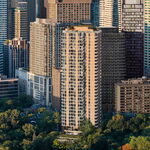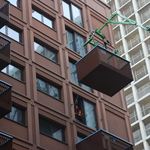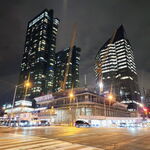I get the idea. But I wonder if the promotional and aspirational value is lost in the analysis. I mean Amtrak manages a cafe car on a 304 seat/5 pax coach Acela. And they must see value in it, if they included it in the Avelia Liberty refresh.
I'm just wondering how Acela makes it work.
Acela Express doesn't even offer an Economy Class and its Business Class (as its lowest class) is priced above Business Class on its regional trains, which means that its passengers are hardly the kind of crowd which would stock up on sandwiches, chips and soda cans before boarding the train:
no because people already assume they will be charged an arm and a leg for snacks and drinks, just like airlines do. They would rather have convenience of time and speed with individual seat comfort over a snack car. This is especially true for short intercities where people would rather watch a movie on their laptop than wander around to a snack car.
This unfortunately matches my own experiences from traveling across Europe, as the restaurant/bistro cars were reliably empty despite offering surprisingly decent and really reasonably priced meals, snacks and beverages - and it actually took me years to start discovering (and appreciating) them, as I had fallen victim of exactly the prejudice (that their offerings would be overpriced and of inferior quality) you described...
Still, having a kitchen in every car must have its costs. There will be a more distributed handling and accounting for cash (although touchless is likely here to stay), liquor must be inventoried in every car, there must be more food wastage (as every coach must be stocked, and one would expect more unsold items returned), handling costs and logistics would be more complex. Many more refrigerators and microwaves and coffee makers to maintain.
When I add up the linear feet of space consumed by the galley in an LRC coach, however, I wonder if a discrete cafe counter really consumes more space.... especially on longer consists.
The galley currently present in every LRC and HEP2 car (also in 8145-8147, but these HEP1 coaches are only used in Northern Quebec) displaces at least 8 seats (if not more) and having one in every single car on the Corridor is certainly an overkill. Fortunately, one of the advantages of having semi-permanent trainsets is that you can much better size the galley space to match the number of seats they serve...
There must be a break-even point. However, having to marshall consists so there is always one snack car will be less flexible so that alone might tilt the equation.
This is exactly the problem of having a dedicated snack/bar car (regardless of whether shares the car with revenue seats or not): whereas it might be worth it on longer trains which usually have maybe 6 revenue cars (wich would equal approximately 42+5*68=382 seats), having a dedicated attendant serving that car would be an overkill on trains 85 and 88 (which usually operate with only 2 coaches).
What I do suspect, given the LRC's inside dimensions, is that VIA and/or Transport Canada also had a keep-em-seated agenda when the LRC came out. If so, that has to go. The ability to move around is important, and it's a way that VIA can differentiate from other modes. Even if there's no snack car to walk to, stretching likely sells.
Nobody stops you from walking around in the train, but indeed, it's more rewarding if the train has a "destination" worth visiting...
The last time a railroad tried to attract a premium customer segment with superior catering ("superlative cuisine in the Deluxe Dining Room Car") was in October 1965:
View attachment 287343
Source: official CP timetable (effective 1965-10-31)
The experiment lasted less than 3 months before CP completely abandoned its Toronto-Montreal and Toronto-Ottawa routes,
as explained by R.L.Kennedy on Trainweb:
I have been made aware of
this quite different account of what motivated the end of CPs Corridor operations between Toronto and Ottawa/Montreal and this is not the first time I've seen conflicting accounts which were more plausible than the one provided by R.L.Kennedy:
CP's decision to cancel the Royal York/Chateau Champlain in January 1966 was not really voluntary and did not amount to a concession that they couldn't compete for passengers in the corridor. CP had not wanted to discontinue the pool trains, and wanted to continue the Royal York/Chateau Champlain. There was pressure on both railways and the government to reinstate Ottawa-Toronto night service, discontinued with the pool trains in October 1965. Overnight Pool trains 33 and 34 on that route had been losing a million dollars a year and CP had no confidence in the future of overnight service in the corridor. It had not given up on the day service. However CN would not agree to start up its own Ottawa-Toronto night service unless CP would concede the rest of the corridor market to CN. Understandably CN didn't want to initiate an unprofitable night train if it couldn't have the more promising day trains to itself. CP bowed to government pressure and took off its day trains.
What really signalled CP's change of heart in the passenger business was the death of president Robert Emerson later in 1966, and his replacement by Ian Sinclair.
Makes somewhat more sense (if you ask me) than CP loosing its nerves without waiting for the summer...
I take from
@Urban Sky post that they don't see value in a coach that doesn't generate revenue. But I wonder how that compares to say one that saves cost, by combining kitchens and freeing up floor space in other coaches for more seating. That said, it may be less pressing as travel times drop with HFR.
I'm afraid that the one attendant stuck in the catered section would still be a deal-breaker, as it simply can't be justified on certain Corridor services (not just on 85-88). Repeated customers expect a standardized travel experience and that precludes having wildly different catering facilities and offerings across the Corridor. However, in the case that HFR becomes so popular that customers recognize it as a brand which is distinct from VIA's other corridor services, you could start pondering such amenities. In a lucky coincidence, the approval of HFR will trigger the second batch of Corridor trainsets and that could be an opportunity to include additional car types to operate longer trainsets with improved facilities on the HFR route, which could also include whichever features you list in your next quote aren't already included in the first batch:
I'd argue that the best bang for buck would be podded seats in business class that allow for privacy and bookable conference rooms that let a whole team work while travelling.
Nitpick: CN attempted an “Executive Class” service on the Rapido a few years later - private accommodations in a sleeper-lounge car, with table service in the lounge area. It didn’t last either, and unlike the CP train I have never even seen a trip report about it.
Less elite but more popular was CN’s Bistro car, coaches converted to full length bar cars which ran on the Rapido in the early seventies. They had pianos and piano players, were modeled as night clubs. The problem (other than the need to switch the cars in and out of their afternoon-only runs) was their mixed success.... pouring a carload of beer into your clientele so they could run amok the rest of the way was not necessarily a good idea. Bar cars attracted a harder drinking clientele. CN didn’t need quite that much alcohol served, even when the Rapido was sold out.
- Paul
I unfortunately have never heard about CN's "Executive Class" (and all Google results seem to be "polluted" by Air Canada having stolen that name in the meanwhile), but I would appreciate any details on this!

This is jumping back, but Superliners are 16 feet 2 inches and Dome cars are either 15 ft 6 inches or 15 foot 10 inches. Are people super sure that 8 — 8! Inches max is a deal breaker? Seriously.
According to
this post on Amtrak Unlimited by a usually very knowledgeable source, the catenary wire had to be removed to ensure sufficient clearance for the domes:
NS VIA Fan said:
A Superliner is 16'-2” and a Park Car is 15'-10”. When VIA started operating Domes at Central Station back in the late '70s the electric catenary had to be removed over several tracks to provide clearance.
If you now look at this picture, you will appreciate how close the catenary wires in Gare Centrale are to the ceiling:
Source:
Wikipedia
So yes, 8 (or even: 4) inches can be the difference between clearing the ceiling or scraping on it...







